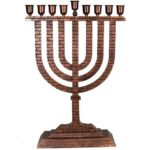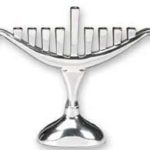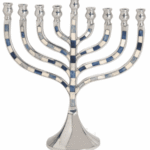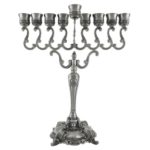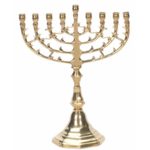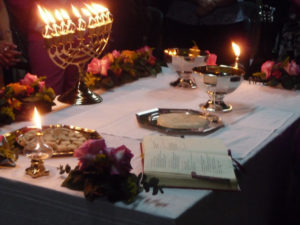
To many Catholics, the Neocatechumenal practice of substituting something that looks like a Jewish menorah for a crucifix on their “altar” is irksome. Why do they do this? Is there a hidden reason?

Daniel Lipschitz, a Jewish convert to the Catholic faith and former itinerant catechist for the Neocatechumenal Way, once challenged Kiko about the use of menorah’s in the Neocatechumenal liturgy. In his autobiography, “L’immondizia Ama Dio” (“The Garbage Loves God”), Daniel writes:
Another time I tried to change his mind regarding a liturgical detail. During the Mass of the Way, the Hanukkah is put on the table, the eight-armed candlestick that is lit during the eight days that lasts the Chanukkah party. The ninth arm is nothing but servant to turn on a light every day, until the eighth day of the festival. I pointed out to Kiko that a nine-branched candelabrum, as it is turned on in all the Eucharistic celebrations of the Way, has no liturgical sense. Annoyed, he refused to listen to me: he said that the number nine was that of evangelization. Maybe, but the number eight is for the Jews, among many other meanings, the Messiah’s number; obviously in Christianity it is the number of Jesus Christ. With this statement, the discussion ended. P. 141
Daniel, of course, was absolutely right. Borrowing a candelabra from the Jewish Hanukkah tradition for use in celebrating the Catholic Eucharist makes no sense for many reasons.
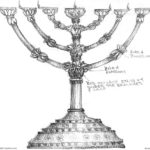
First, the Hanukkah menorah is not the biblical menorah. In Exodus 25:31-40, we read of the seven branched menorah commanded by God for use in the Temple.
After the the Maccabean Revolt against the Seleucid Empire, the Maccabees reestablished proper Temple worship in the Temple (140 B.C.). Hanukkah is the Jewish holiday that commemorates the re-dedication of the Temple by the Maccabees.
Before reestablishing Temple worship, the Maccabees restored all of the sacred vessels and accouterments to the Temple. The celebration of Hanukkah commemorates a miracle whereby a small amount of oil for the sacred candelabra, less than a day’s worth, lasted eight days.
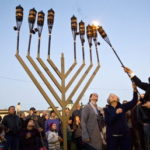 For this reason, the Hanukkah menorah has eight main lights, and a ninth “service” light, called the the “shamash” (“servant” or “attendant”). This light is used to light the other lights and stands ready to “serve” in case one of the other lights go out. It stands either higher, or lower, or apart from the other lights. Here are some typical Hannukah menorahs:
For this reason, the Hanukkah menorah has eight main lights, and a ninth “service” light, called the the “shamash” (“servant” or “attendant”). This light is used to light the other lights and stands ready to “serve” in case one of the other lights go out. It stands either higher, or lower, or apart from the other lights. Here are some typical Hannukah menorahs:
Kiko Arguello, then, replaced the crucifix on his “Eucharistic tables”, with a modified version of a Hanukkah candelabra. In Kiko’s “menorahs”, all nine lights are horizontally level with each other, and there is no “shamash” or service light:

Moreover, the number “nine” has no known connection in either Jewish or Christian tradition to the Messiah, nor to the Eucharist. Nor, for that matter, is the number nine associated in any way with “evangelization”, as Kiko told Daniel.
The number “eight” does, however, have significance to Christians. You may remember that God rested on the seventh day (Gen. 2:2), which is the basis for the Jewish observance of the Sabbath, and Jesus rose from the dead on the day after the Sabbath (Mt. 28:1), on the “eighth day”.
But Kiko Arguello’s appropriation of a modified version of a Hanukkah candelabra for the celebration of the Eucharist might not be just an example of his attempt to create a pseudo-Jewish “brand” for his sect. No, it may be much more than that.
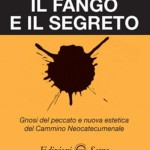 Lino Lista, a prolific critic of the Neocatechumenal Way,discusses Kiko’s conversation with Daniel Lipschitz in his book, “Il Fango e il Segreto“:
Lino Lista, a prolific critic of the Neocatechumenal Way,discusses Kiko’s conversation with Daniel Lipschitz in his book, “Il Fango e il Segreto“:
“Whatever you think in matters of symbolism, to invent a candelabra such as Kiko did, you take the risk that someone can surmise that it intends to mean the “reconstruction of the Church and its re-dedication,” as a Roman neocatechumenal once asserted. This point of view, this reconstruction of the Temple, is less awkward than the meaning of “evangelization” assigned by its maker [Kiko]. This causes us to consider the relationship between the image [Kiko’s candelabra] and the restoration of the Jewish shrine in the story of the Maccabees and the Talmud. The idea of the Roman neocatechumenal about the connection between the visible object of Kiko and the concept associated with it … is more logical than the extemporaneous and irritated explanation of Arguello.” p. 70-71
Lista hit the nail on the head.
Remember that the celebration of Hanukkah commemorates the re-establishment and restoration of proper worship in the Temple and the miraculous event associated with it. Keep in mind too, that the proper symbol present on or near the altar during the Mass, according to the General Instruction on the Roman Missal (GIRM)(308), is a crucifix. The GIRM mandates this, of course, because the Eucharist is a sacrifice that “re-presents (makes present) the sacrifice of the cross” [CCC 1366].
The use of a Hanukkah candelabra by the Neocatechumenal Way is meant to highlight the fact that their liturgy is the true, restored, liturgy and that the Eucharist, and Christ’s Passion too, are not in any sense a sacrifice.
